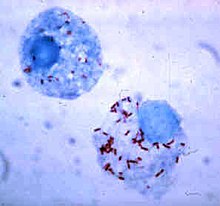Rickettsia is a genus of nonmotile, gram-negative, nonspore-forming, highly pleomorphicbacteria that may occur in the forms of cocci (0.1 μm in diameter), bacilli (1–4 μm long), or threads (up to about 10 μm long). The term "rickettsia" has nothing to do with rickets(which is a deficiency disease resulting from lack of vitamin D); the bacterial genus Rickettsia instead was named after Howard Taylor Ricketts, in honor of his pioneering work on tick-borne spotted fever.
Properly, Rickettsia is the name of a single genus, but the informal term "rickettsia", plural "rickettsias", usually not capitalised, commonly applies to any members of the order Rickettsiales. Being obligate intracellular parasites, rickettsias depend on entry, growth, and replication within the cytoplasm of living eukaryotic host cells (typically endothelialcells).[9] Accordingly, Rickettsia species cannot grow in artificial nutrient culture; they must be grown either in tissue or embryo cultures; typically, chicken embryos are used, following a method developed by Ernest William Goodpasture and his colleagues at Vanderbilt University in the early 1930s.
Rickettsia species are transmitted by numerous types of arthropod, including chigger, ticks, fleas, and lice, and are associated with both human and plant diseases.[10] Most notably, Rickettsia species are the pathogens responsible for typhus, rickettsialpox, boutonneuse fever, African tick-bite fever, Rocky Mountain spotted fever, Flinders Island spotted fever, and Queensland tick typhus (Australian tick typhus).[11] The majority of Rickettsia bacteria are susceptible to antibiotics of the tetracycline group.
| Schematic ribosomal RNA phylogeny of Alphaproteobacteria | ||||||||||||||||||||||||||||||||||||||||||||||||||||||||||||||||||||||||||||||
| ||||||||||||||||||||||||||||||||||||||||||||||||||||||||||||||||||||||||||||||
| The cladogram of Rickettsidae has been inferred by Ferla et al. [15] from the comparison of 16S + 23S ribosomal RNA sequences. |
https://en.wikipedia.org/wiki/Rickettsia

No comments:
Post a Comment